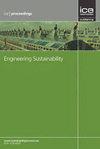结合可持续混凝土和填充材料的新型土-结构相互作用的数值模拟
IF 1.5
4区 工程技术
Q3 ENGINEERING, CIVIL
Proceedings of the Institution of Civil Engineers-Engineering Sustainability
Pub Date : 2022-11-16
DOI:10.1680/jensu.22.00062
引用次数: 1
摘要
由于城市改造活动、自然灾害(地震、海啸、风暴、洪水、飓风、龙卷风、火山爆发、火灾、沙尘暴)、区域和全球战争,产生了数十亿吨的废弃混凝土。因此,废旧混凝土的修复工艺是近年来的重要研究课题之一。可持续性概念在对天然混凝土材料的需求和废弃混凝土的修复过程之间提供了一个主要的桥梁。再生骨料和再生混凝土骨料是通过对废旧混凝土进行回收处理而获得的可持续性材料。近年来,许多实验和数值研究表明,这种可持续材料是天然骨料的替代产品。据作者所知,这项研究的原创性:(a)首次详细报道了包含可持续混凝土和填充材料的土-结构相互作用的综合数值模拟结果;(b)调查了现有数值模拟模型在可持续土-结构相互作用问题中的适用性;(c)对可持续土-结构相互作用的结构行为进行了现实的模拟。在本研究中,对文献中的研究做出了贡献,对传统和可持续材料结合的土壤上的基础梁进行了全面的数值模拟。这些基础梁的混凝土性能考虑了传统(天然骨料)混凝土和可持续(再生骨料)混凝土的四种不同的再生混凝土骨料比(25%,50%,75%和100%)。此外,采用六种不同的混合再生骨料作为充填材料,考察了土体的物质条件。基于数值模拟,基于土的传统和可持续基础梁的挠度、旋转、弯矩、剪力和弹簧力能力随再生混凝土骨料和混合再生骨料比的不同而略有不同。最后,对比了采用传统材料和可持续材料的土-结构相互作用构件的数值模拟结果,表明适用于传统地基梁的土-结构相互作用模型也适用于可持续构件。本文章由计算机程序翻译,如有差异,请以英文原文为准。
A novel numerical simulation of the soil-structure interaction incorporating sustainable concrete and filling materials
As a result of urban transformation activities, natural disasters (earthquakes, tsunamis, storms, floods, hurricanes, tornadoes, volcanic eruptions, firestorms, dust storms), regional and global wars, billions of tons of waste concrete occur. Therefore, the remediation process of waste concrete is one of the critical research topics of recent years. The sustainability concept provides a primary bridge between the demand for natural concrete material and the remediation process of waste concrete. Recycled aggregate and recycled concrete aggregate, which may be named sustainable materials, are obtained by the recycling process of waste concrete. Many experimental and numerical studies have been conducted to exhibit that this sustainable material is an alternative product to natural aggregate in recent years. According to the authors’ best knowledge, the originality of this study: (a) this is the first time that comprehensive numerical simulation results of soil-structure interaction containing sustainable concrete and filling materials are reported in detail, (b) investigation of the applicability of existing numerical simulation models in sustainable soil-structure interaction problems, (c) contribution the realistic simulation of the structural behavior of the sustainable soil-structure interactions. In this study, which contributed to the studies in the literature, a comprehensive numerical simulation of foundation beams resting on soils incorporated with conventional and sustainable material has been performed. The concrete properties of these foundation beams are considered with conventional (natural aggregate) concrete and sustainable (recycled aggregate) concrete with four different recycled concrete aggregate ratios (25%, 50%, 75%, and 100%). In addition, the material conditions of soils are regarded with six different mixed recycled aggregates as a filling material. Based on the numerical simulation, the deflection, rotation, bending moment, shear force, and spring force capacities of conventional and sustainable foundation beams resting on soils exhibited slightly different behavior depending on the recycled concrete aggregate and mixed recycled aggregate ratios. Finally, comparing the numerical simulation results of soil-structural interaction members incorporating conventional and sustainable materials indicated that the soil-structure interaction modeling process applied to conventional foundation beams resting on soils is also valid for sustainable members.
求助全文
通过发布文献求助,成功后即可免费获取论文全文。
去求助
来源期刊

Proceedings of the Institution of Civil Engineers-Engineering Sustainability
ENGINEERING, CIVIL-ENGINEERING, CIVIL
CiteScore
3.70
自引率
16.70%
发文量
44
审稿时长
>12 weeks
期刊介绍:
Engineering Sustainability provides a forum for sharing the latest thinking from research and practice, and increasingly is presenting the ''how to'' of engineering a resilient future. The journal features refereed papers and shorter articles relating to the pursuit and implementation of sustainability principles through engineering planning, design and application. The tensions between and integration of social, economic and environmental considerations within such schemes are of particular relevance. Methodologies for assessing sustainability, policy issues, education and corporate responsibility will also be included. The aims will be met primarily by providing papers and briefing notes (including case histories and best practice guidance) of use to decision-makers, practitioners, researchers and students.
 求助内容:
求助内容: 应助结果提醒方式:
应助结果提醒方式:


